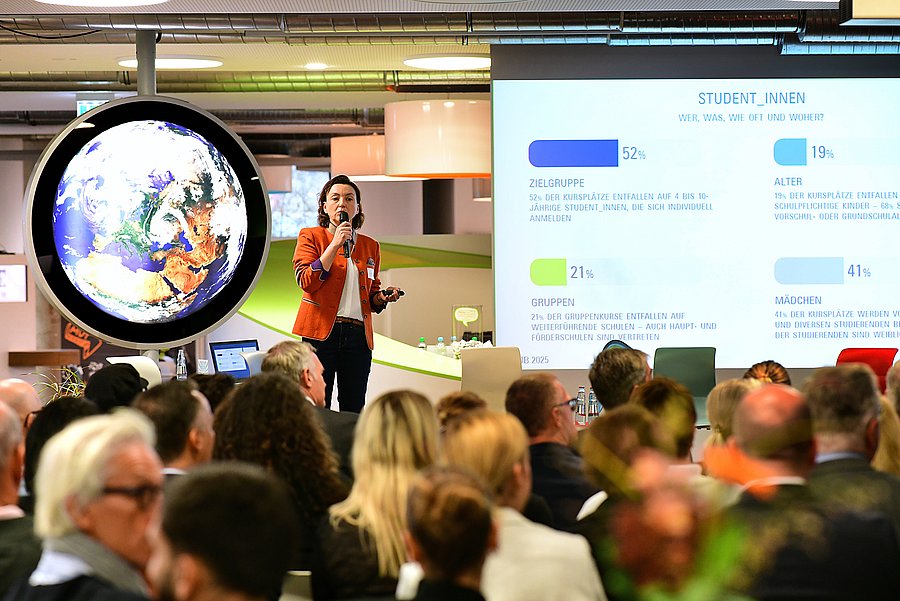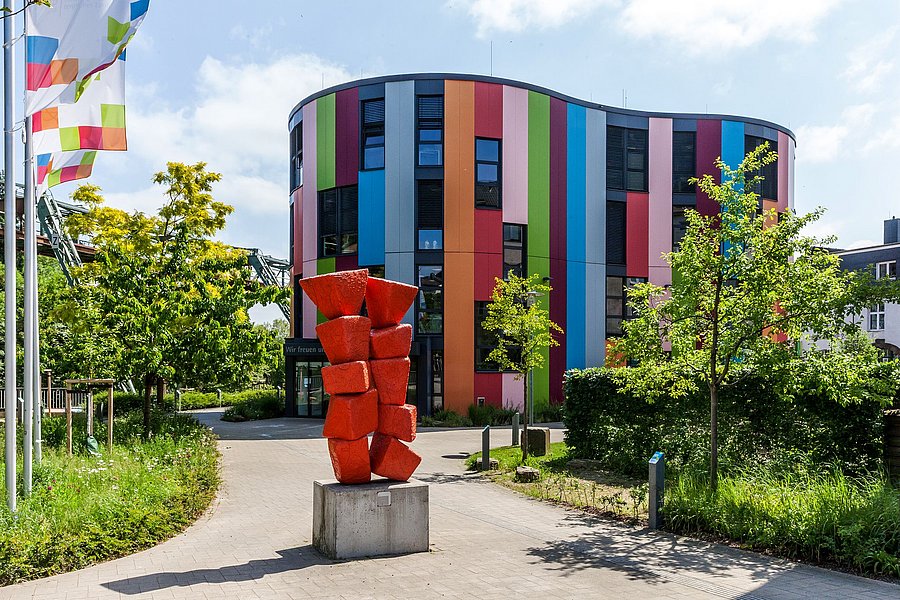Evaluation
More than just pretty numbers: On the value of extracurricular education using the example of Wuppertal Junior Uni

Education economist Dr Anna Makles presented the findings from the latest evaluation report on the Junior University. // Photo: Bettina Osswald
The Wuppertal Junior Uni is an innovative, extracurricular learning centre. It offers young people between the ages of four and 20 practical courses for joint experimentation, research and design in various subject areas - from natural sciences, mathematics, technology and engineering to humanities and social sciences, economics, art and culture. The institution is almost exclusively privately funded.
Since its foundation, the Junior Uni has been scientifically supported by the Wuppertal Institute for Research in Economics of Education, WIB for short. The institute, which is based at the University of Wuppertal, regularly reviews whether the goals set by the Junior Uni are being achieved and what development potential exists. "The example and approach of the Junior Uni can also serve as a role model beyond the Bergisch region," emphasise education economists Prof Dr Kerstin Schneider and Dr Anna Makles from the WIB Board.
The current report shows what extracurricular learning centres can achieve. The authors have no doubt that they are important. "Our regular review shows that it is worthwhile for a city or region to be able to offer such a programme," explains Kerstin Schneider. Schools would not see these programmes as competition. On the contrary, extracurricular facilities are a welcome and necessary part of the education system. Just one aspect that emphasises their importance is the small group size and the associated opportunities for individual support. There are often more than 30 pupils in a school class. The average number of course participants at the Junior Uni in Wuppertal is twelve.
The Junior Uni is becoming increasingly colourful
This figure is one of many from the latest status report on the Junior Uni, which the WIB presented today at a sponsorship event at the Junior Uni. Managing Director Dr Ariane Staab from the Junior Uni: "For us, external evaluation is far more than just a matter of course - it is a valuable tool for critically reflecting on our work, developing it further and ensuring the quality of our educational programmes in the long term. Only by looking from the outside can we ensure that we constantly fulfil our claim of offering all young people the best possible learning conditions and the opportunity to discover their potential and find guidance."
The general conclusion of the report: the Junior Uni is becoming increasingly colourful. Since it was founded in 2008, the proportion of girls taking part in the courses has increased, the participants attend all types of schools, the courses on offer have become more diverse in terms of subject matter, there are also courses specially tailored to daycare centres and school groups and the composition of the lecturers is also becoming increasingly diverse. In the Department of Technology and Engineering, the proportion of girls and diverse people is only 22 per cent on average. "It therefore remains a key challenge to get girls more interested in technical subjects," say the authors of the report.
The Junior Uni is therefore constantly testing how to make technical courses attractive to girls. "We pick up girls thematically with activities such as designing jewellery and use technical processes such as 3D printing or metal soldering in these courses," explains Staab. The next reports from the WIB will then show whether the measures can contribute to more girls enrolling on technology courses.

Junior Uni in Wuppertal // phot Peter Krämer
Die Junior Uni wird immer bunter
Die Zahl ist ein Ergebnis von vielen weiteren aus dem neuesten Statusbericht zur Junior Uni, den das WIB heute im Rahmen einer Fördererveranstaltung in der Junior Uni vorgestellt hat. Geschäftsführerin Dr. Ariane Staab von der Junior Uni: „Die externe Evaluation ist für uns weit mehr als eine selbstverständliche Pflicht – sie ist ein wertvolles Instrument, um unsere Arbeit kritisch zu reflektieren, weiterzuentwickeln und die Qualität unserer Bildungsangebote langfristig zu sichern. Nur durch den Blick von außen können wir sicherstellen, dass wir unseren Anspruch, allen jungen Menschen bestmögliche Lernbedingungen und die Möglichkeit bieten, ihre Potenziale zu entdecken und Orientierung zu finden, immer wieder neu erfüllen.“
Das allgemeine Fazit des Berichts: Die Junior Uni wird immer bunter. Seit ihrer Gründung 2008 hat sich bei den Kursteilnehmenden der Anteil an Mädchen erhöht, die Teilnehmenden besuchen alle Schulformen, die angebotenen Kurse sind thematisch vierfältiger geworden, es gibt zudem speziell auf Kita- und Schulgruppen zugeschnittene Angebote und auch die Zusammensetzung der Dozierenden wird immer diverser. Im Fachbereich Technik und Ingenieurwissenschaften liegt der Anteil der Mädchen und diversen Personen im Schnitt bei nur 22 Prozent. „Damit bleibt es eine zentrale Herausforderung, Mädchen gezielter für technische Themen zu begeistern“, so die Autorinnen des Berichts.
Kontinuierlich testet man an der Junior Uni daher, wie man technische Kurse für Mädchen attraktiv gestalten kann. „Wir holen Mädchen thematisch mit Aktivitäten wie beispielsweise dem Designen von Schmuck ab und setzen in diesen Kursen technische Verfahren wie den 3D-Druck oder auch das Löten von Metall ein“, schildert Staab. Die nächsten Berichte aus dem WIB sollen dann zeigen, ob die Maßnahmen dazu beitragen können, dass sich mehr Mädchen für Technikkurse anmelden.
Further results and full report
- This evaluation report on the Junior Uni also took a closer look at the course leaders for the first time. The WIB looked at the diversity of the course leaders in terms of their gender and migration background and analysed how this diversity influences the composition of the participants in the courses and their return rates.
- Course leaders have become significantly more diverse in recent years. The proportion of women and course leaders with a migration background has increased noticeably - including in STEM subjects. In 2024, 53% of courses were led by women; a further 30% by mixed teams of women and men.
- While 67% of courses were run by people without a migration background, 25% were run by teams of different origins, i.e. one person with and one without a migration background. This development helps to reach new target groups and increase the attractiveness of the courses on offer.
- The heterogeneity of the course leaders is also reflected among the students: in 2024, 2,746 of a total of 6,679 participants (41%) had a migration background.
- The choice behaviour of participants shows clear patterns: girls and diverse children more often prefer courses led by women (51%), while boys tend to attend courses led by men (38%). However, the origin of the course leaders and the content of the courses have no significant influence on whether the children book further courses.
- The return rates depend heavily on individual characteristics: Boys return more often than girls or diverse children; younger children more often than older children; children living outside Wuppertal, on the other hand, return less often.
The full report, including an overview of the key findings, is available to download here:

Extracurricular learning centre: Since its founding in 2008 until the end of 2024, Junior Uni has offered 120,000 places in over 10,000 courses. // Photo Bettina Osswald
Although the idea of the Wuppertal Junior Uni, which was completely new at the time of its foundation, is now also being implemented in similar models elsewhere, the remarkable openness to continuous evaluation by an independent research institute remains a particular feature. "This illustrates the Junior Uni's high standard of systematically testing its own effectiveness and developing further," confirms Anna Makles.
This openness allows scientists to make well-founded statements about extracurricular educational programmes for children and young people. These can be used by other institutions as a source of inspiration and by education policy-makers as a basis for decisions on the design of various programmes to promote extracurricular activities or individual development.
Not just a nice-to-have
Why is it not only productive for the Junior Uni to identify potential, successes and possible strategies that pave the way? Junior Uni Managing Director Ariane Staab gives an example: "Getting girls interested in technical subjects is not just a nice-to-have. If their technical interest leads to a scientific career, for example, this contributes to a multifaceted view of future research questions and problem solutions." Anna Makles from the WIB adds: "It is also important for activities relating to the development of skilled labour to know approaches that can reach as many children as possible, regardless of their background and social class."
The report attests to the Junior Uni's positive results in these areas: Course participants from the Bergisch city-triangle now largely correspond to the composition of the overall population. In 2024, 41 per cent of participants had a migration background. Pupils from special schools also take part in the courses.
Attending Junior Uni influences cognitive development
Kerstin Schneider and Anna Makles emphasise that it is important to uncover simple correlations in their report - such as the observation that girls register for courses with female instructors more frequently than average. In many cases, we can only speculate about the underlying reasons. With one exception: in the past, the WIB has already been able to prove that attending Junior Uni has a causal influence on the cognitive development of young children. To this end, the WIB looked at the school entry examination, i.e. daycare centre children at the transition to the first school class, and compared those who attended Junior Uni with those who did not. If they had the financial resources available, they would like to build on this at the WIB and analyse the impact of extracurricular places of learning for older children and young people even more extensively.
"I would also like to be able to make the statement 'The Junior Uni works' in other contexts," says Anna Makles. At the WIB, they already know how they would approach such a research project. "We want to investigate whether attending the Junior Uni has a demonstrable influence on later career choices. We are particularly interested in the so-called STEM subjects, i.e. maths, IT, science and technology," explains Kerstin Schneider. However, this investigation is only possible as part of a larger-scale study in a control group design, for which no funding has yet been found.
The WIB is therefore currently continuing to look for suitable funding programmes and hopes for a successful application in the not too distant future. "Understanding the actual causal relationships and mechanisms is crucial for the implementation of targeted and needs-based measures in the education sector," concludes Kerstin Schneider.
About the Junior Uni
The Wuppertal Junior Uni for the Bergisches Land region is an extracurricular educational institution for young people between the ages of four and twenty. It is privately financed and has broad social support. With more than 120,000 course places filled and over 10,000 courses organised by the end of 2024, the Junior Uni has made a name for itself as an extracurricular learning centre for practical scientific education since it opened at the end of 2008. The institution now reaches interested girls and boys far beyond the city limits of Wuppertal.
About the WIB
The WIB - Wuppertal Institute for Research in the Economics of Education is a cross-faculty academic institution of the University of Wuppertal, supported by the Schumpeter School of Business and Economics and the Institute for Educational Research (IfB) in the School of Education. The WIB's main research objective is to create a centre of excellence for research in the economics of education, which is also responsible for promoting young academics in this field of research. In particular, the institute analyses current and relevant issues in the field of educational economics, educational research and educational policy.
